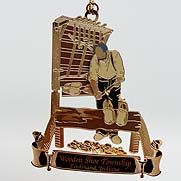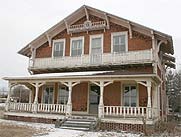2010 Essays: Honorable Mention– The Hysteria in Indiana Basketball Hoosiers’ Enthusiasm for Local Teams by Grant Welp
“Basketball may have been born in Masssachusetts, but its real origin and the center of the sport is in Indiana” —Dr. James Naismith
“In 49 states it is just a game, but this is Indiana” (Welp 4). Hoosiers have always had enthusiasm for their local boys’ basketball programs. Depicted in the movie Hoosiers as well as anywhere, Milan—known in the movie as “Hickory”—advances through the tournament and to the state finals against Muncie Central. Muncie Central had an enrollment over 1600, while Milan had 161 students and only 75 boys. (Indiana 1) In Indiana basketball, one or two great players can spark a run to state—such as Bobby Plump—who hit the last-second game-winning shot in the state championship—and Ray Craft, Milan’s leading scorer. Milan’s run to state in 1951 is not the only “underdog” story in Indiana’s history. Led by Oscar Robertson, Crispus Attucks became the first all-black school to win state in 1956. (3) Everyone strives to hold the honor as the “top-dog” in the state; therefore, when a small-town school full of burly farm boys makes a run into the final four, Hoosier Hysteria hits its peak.
The game of basketball, or Hoosier Hysteria, would not exist today without James Naismith’s development of a new activity for the YMCA. The first time he experimented in 1891, the game included 18 players, nine on each squad, and the ball would have to travel into a peach basket with a small hole in the center of it. When someone would score, a player would have to grab a broom stick and push the ball out of the basket. Everyone found this inconvenient, but the ball—a soccer ball at the time because of lack of funds—went into the basket only one time in thirty minutes. Therefore, the game ended one to zero. (Faurschou 1) Professional teams started around 1914, but teams struggled for attendance all the way through the 1920s because people came only when hockey and football games were not on the same day. The ABL, American Basketball League, finalized the idea of professional teams by forming corporations to fund games between teams. However, with people struggling to buy food during the Depression, basketball was not an option for most Americans and the “League” had to suspend play in the 1931-1932 and 1932-1933 seasons. (Faurschou 3)
Where did the enthusiastic love for American basketball originate? Rich Welp, a sectional champion in 1959 with the Huntingburg Happy Hunters, says, “We just came out of the Great Depression and World War II, and it brought Hoosiers and Americans a new tradition. It was something that people could hold onto and enjoy, once families could afford it. Parents were so excited that they allowed kids to stop working on the farm and play. It provided people a sample for good times.” By watching professional and college games on television, children began catching on to the game, allowing the game to spread rapidly. Soon enough, kids had a goal in their backyard, barn, or garage. Eventually, high school teams sprouted up. The game evolved in the Hoosier state, and Indiana became a hot spot for college prospects (Indiana 3). After the game became known in Indiana, it launched a fad that still remains today. Analysts give some of the credit to the success at Indiana University with multiple championships [1940, 1953, 1976, 1981 and 1987] and Bob Knight’s consecutive winning seasons during his tenure from 1971-2000. The tradition of other Indiana colleges adds to the spark for Hoosiers’ interest; Purdue, Indiana State, Butler, and even Evansville have created national publicity at the collegiate level. (Schuler 229)
To show their love for the game, Hoosiers have built mammoth gyms compared to the rest of the United States or even the world. Indiana has 28 out of the 36 largest high school gyms in the country—nine out of the top ten largest. The lone gym not in Indiana, Alfred J. Loos Fieldhouse located in Dallas, Texas, holds 7,500 spectators (Indiana 3, King 2). Indiana has 30 gyms that hold over 5,000 people, and the top nine in the state have the capacity to seat over 6,000 people. Located in northern Indiana, New Castle High School’s Chrysler Fieldhouse, opened in November 21, 1959, remains the largest high school gym in the nation with a capacity of 9,325 people. With this gym being a monument in our heritage, New Castle athletic director Mike Bergum says, “Someone stops by every week to see it.” Chrysler Fieldhouse has been used for more than just high school basketball; it has hosted NBA, Globetrotter, Purdue, and Indiana basketball games. Indiana has other gargantuan gyms: Anderson’s Wigwam (8,996), Seymour’s Lloyd E. Scott Gymnasium (8,110), and Richmond’s Tiernan Center (8,100). (King 1-2) However, the closest connection to Forest Park High School stands in Huntingburg and cost approximately $350,000 to construct. Built in 1951, Memorial Gym seats 6,092, more than the population of Huntingburg at the time of construction. (Welp 1)
The phenomenon of basketball in Indiana progressed to where the atmosphere of high school games stood unmatched anywhere else. The inventor, James Naismith, came to watch an Indiana high school tournament game and was fascinated with what he saw (Indiana 2). According to Welp, “Everyone went to the sectional if they could find a ticket and a ride. It didn’t matter if your team was playing or not. Each team had tickets assigned by enrollment so the largest school received the most tickets. Generally, everyone [already eliminated] ‘rooted’ for the smaller team which meant the largest school had most of the gym cheering against them.” Because the game started in or near a barn, tight games between two competitive sectional foes became known as “barnburners” (Schuler 229).
Many Hoosiers still adore the game of basketball and cheer passionately for their team, but some say Hoosier Hysteria has lost its popularity. These people argue that an environment, such as Memorial Gym, had a capacity crowd filled to its brim with temporary bleachers twenty years ago, but today’s culture cannot fill the stands, without the extra seats, on a sectional championship game. The effort and enthusiasm of players still remains high today, but the fans may have lost a portion of their appreciation for the game. Welp places the blame on the distance teams have to travel today by saying, “People were closer to come and just watch.” In today’s sectional, teams can travel up to an hour to play every night. That can be a long drive for those supporting the team, especially when a team could play three times in a week. (Welp 1-2) Students and the surrounding community also have other activities other than basketball on Friday nights. “The Friday night boys’ basketball game is certainly no longer the only game of the week or the only thing to do on weekends,” says Larry Klein, a coach for the Ferdinand Crusaders from 1968-1971 and a Forest Park Ranger fan today. Also, with the addition of girls’ teams in high school, many parents in the community grew busier throughout the week. Furthermore, since high schools in the neighboring area have consolidated, it withers the small communities’ interest because they have lost their schools. (Schuler 230) Towns such as Birdseye and Holland are just two examples of victims of consolidations in this area.
Although Indiana’s passion for the game may have diminished some, the hysteria around their basketball still stands unmatched anywhere else. Communities still rally around their team when tournament time arrives; the atmosphere of a gym can be deafening when two competitive teams match up in March. Some people talk about reliving the experience of Hoosier Hysteria because of the great memories they have as a former players. For Rich Welp, he takes the experiences he has had and treasures them, but he also has many other goals he has achieved in his life. He believes his other accomplishments in his life are far more important than playing basketball on a sectional championship team, scoring 39 points in a high school game at Roberts Stadium or playing collegiate ball at Purdue University. According to Rich Welp, you may go to college for a sport or you may currently play a sport in high school, but he wants people to remember one thing: “School is for an education. . . . No matter what sport you may be in, you’ll [most likely] go pro in something other than sports.” (Welp 4)



